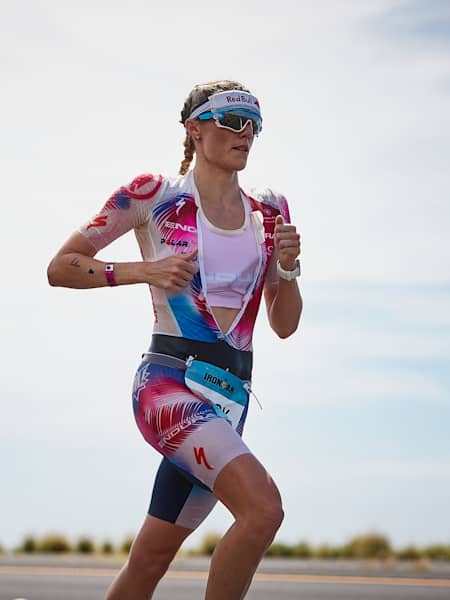The date for the 11th edition of the Wings for Life World Run is May 5, 2024, and registration will be available well before 2023 is out. You can sign up to be notified as soon as registration opens at www.wingsforlifeworldrun.com
Running has amazing benefits for body and mind. But, like all sports, it does take its toll on your body, as Lucy Charles-Barclay knows.
Charles-Barclay got into triathlon in 2014 after a decade spent swimming at the highest level – including an Olympic Trials final for Team GB. It took her less than a year to become a double world champion in the Female 18–24 age group, winning both the Ironman and 70.3 titles, in 2015. In 2021, she was crowned Ironman 70.3 World Champion in St. George, Utah.
Charles-Barclay’s success is outstanding, but was never assured: just because she could swim, it didn’t mean she could run. When it comes to building up her winning strength – and preventing injury – these are her go-to exercises.
Whatever your level of experience, they’re guaranteed to up your PB game.
01
Deadlifts
Deadlifts strengthen the muscles that run down the back of your body
© David Tittle/Red Bull Content Pool
“A lot of runners suffer from the same postural issues as office workers (rounded shoulders, tight and overactive quads and hip flexors),” says Charles-Barclay. “The deadlift is the perfect antidote as it strengthens all the muscles that run down the back of your body. This will help with balancing out your strength, maintaining proper posture, and mitigating muscle imbalances and overuse injuries from running.”
02
Squats
“Done properly, squats are a great mobility and strength movement. They should be a staple in everyone’s fitness programme,” enthuses Charles-Barclay. “They’re great for strengthening your quads, glutes, hamstrings and lower back, and will help you to build the strength you need to pound the pavements pain and injury-free.”
03
Lunges
“There is a big functional carryover from lunging to running, with lunges working on very similar physical qualities needed to run well,” Charles-Barclay explains. “A walking lunge is basically slow-motion running through a greater range of motion, requiring extra strength, mobility, and stability. Being able to lunge well with extra weight, with stability and structural integrity through the hips, knees, ankles and feet should be a pre-requisite before doing any sort of consistent running training.”
04
Face pulls
“A staple exercise for anyone who’s trying to fend off rounded shoulders,” says Charles-Barclay. “Face pulls will strengthen all the ‘postural’ muscles in your upper back and shoulders, helping you to adopt a more upright posture when you run.”
05
Monster walks
“Walking with a band around both ankles will have you feeling the burn in your glutes very quickly,” warns Charles-Barclay. “Isolation work for the glutes and hip stabilizers can be a great way to get your glutes firing again, especially if you spend a lot of time sitting. When running, stronger glutes can help support your lower back, knees, ankles and feet.”
06
Farmer's walks
“Basically walking with moderate-to-heavy weights in each hand,” Charles-Barclay explains. “This very simple (but not easy) exercise has a big carryover to any athletic endeavours. It will help to strengthen and stabilise everything involved in the gait pattern, which means it will help you to get better at running and increase your capacity to work harder, for longer.”
07
Bear crawls
“The act of crawling helps us maintain and strengthen the ‘wiring’ in our brains and nervous systems needed for efficient movement and running,” says Charles-Barclay. “Getting our knees off the floor takes things to the next level in terms of strength, control and stability requirements, and will have a big carryover to running performance and capacity.”
08
Sled/prowler push
“This exercise is seriously hard work, challenging the strength and power in your legs – as well as your cardio fitness. If you ever need to run up hills, sled pushes are a great training tool.”
09
Hanging and hanging leg raises
“Literally just hanging from a bar can have loads of physical benefits for a runner, like decompressing and aligning the spine, mobilising and stabilising the shoulders, and strengthening our arms and grip,” says Charles-Barclay. “Adding knee or leg raises will make everything harder, and will also help to build abdominal and hip flexor strength.”
10
The World’s Greatest Stretch
“The long lunge position is great for opening up the hip flexors on the rear leg, and a wide stance on the front leg becomes a nice adductor (groin) and glute stretch,” says Charles-Barclay. “From this position, extend and rotate through the thoracic spine (upper back), which is great for helping improve your mobility. This stretch targets the same muscles and fascial lines used when running, so will translate directly into better range of motion when out on the road.”












